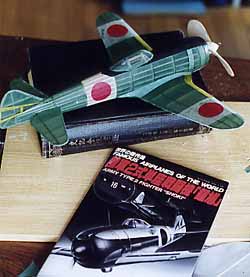Nate Sturman's Ki44 Shioki
 |
The Ki44 Shioki, also referred to as the "Type II Army Fighter" (Tojo), was a heavily armed fighter with small wings. Its development was ordered on the same day in 1939 as that of the Hayabusa, interestingly, as if the generals wanted to cover their bets. The one thing that they, under the influence of Douhet's thesis, failed to comprehend was the need for a supercharger and the first encounters by this plane with B-29s over Japan were disppointing as a result, and "human shell" ramming tectics were employed. These were perhaps the first such systematic "Special Attacks."
Unlike the viceless Hayabusa (Oscar), the Shioki was sometimes lost in approach and departure accidents due to some quirks at low speeds and inexperienced pilots. Spinning was prohibited. In someways this airplane resembled the P-39 due to these limitations. It incorporated air combat flaps but they were seldom exploited properly in the heat of combat by the average green pilots. This plane also had self-sealing outboard wing tanks, which were evaluated as ineffective in USAAF tests. Like the Zero and Raiden there was a fuel tank ahead of the cockpit, a survivability problem for the interceptor pilots who of course had to escape if they could.
|
My 1/24th scale model flies beautifully with an enlarged stab, scale fin, scale dihedral. The knife edged LG/LE fillet progresses to a 12% Clark progression where it comes into the straight LE portion. This serves to help ensure longitudinal stability without washout, not advisable with so little lift to throw away. The plane weighs in at about 30 grams all up and has flown away twice, amazing the onlookers each time.
Note: The Type II fighter (Shioki) shouldn't be confused with the Hayabusa (Type I fighter) Series II, the most numerous "short winged" Oscar; the 4 gunned, cannon armed Shoki had much less wing area and much more power (1,5-700 hp as against 1150.) All Oscars remained 2 gun fighters, and not for a lack of trying; even attempts to fit cannon on Mark IIIs were basically unsuccessful.
The large black book under the Shioki is a famous edition of Sima Qian's (later Han Dynasty) "Book of History" with commentary by the comparatively modern Japanese scholar Takigawa Kametaro, a Sino-Japanese classic of a more peaceful type. Shioki's served in every theater in WWII and a lot were based in China.
email to Nate | return
Copyright 1998, Thayer Syme. All rights reserved
